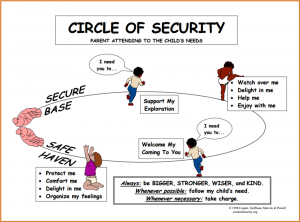You may have heard about ‘Attachment Theory’ or ‘Bonding’ in relation to young children and parenting. At QEII, we support parents to build a secure attachment for their baby by using the Circle of Security model of attachment theory. The model has seven key steps to healthy attachment that are easily understood and provide parents essential guidance for the early years and beyond. They are important points for all of us who may relate to, and be significant in, a child’s life.
The seven steps are:
1. The name of the game is delight: babies are ‘hard wired’ to experience joy with their caregivers in the early months of life. Researchers are finding that mutual joy is the basis for increased brain development. A baby feels more secure knowing that “Life is good, because my caregiver enjoys life when she/he is with me.”
2. Every baby needs a holding environment: babies soak up affection and love through their skin. Gentle touch shares the tenderness that every infant requires. Playful touch encourages joy. Holding your baby not only provides pleasure and reassurance, it is essential to helping soothe and organise difficult feelings.
3. The eyes have it: gaze into your babies eyes from the first day of life, and pay close attention when your child wants to look back. At about six weeks, your child will regularly focus in on your eyes and read what they are “saying”. Lots of pleasurable eye contact will translate into a feeling of reassurance and connection for your baby.
4. Whenever possible follow your babies lead: security of attachment requires a caregiver who is sensitive and responsive to their child’s needs. Your willingness to answer subtle requests for attention, comfort, holding, exploration, and discovery (with you nearby) will provide an increased sense of security for your child.
5. You can’t spoil a baby: contrary to those who might say that you will harm a child if you are ‘too responsive’ to their needs, it isn’t possible to spoil a baby in the first 9-10 months of life. Researchers are finding that the most responsive parents actually have children who are less demanding and more self-reliant as they grow older.
6. Stay with you child during difficult feelings: young children often have upset feelings (anger, hurt, sadness, fear) that are too difficult to manage on their own. When your child has an intense feeling, stay with them until the feeling has been worked through. Your child will learn basic trust: “Someone is here when I am in difficulty and pain”, and I can count on good outcomes to follow difficult experience”.
7. Talk out loud about feelings: from a child’s earliest days, talking out loud about feelings (your child’s and your own) will begin to help the child to eventually label feelings and realise that they can be shared. As a child gets older, they will then realise that intense feelings can be named (mad, sad, glad and afraid) and discussed with another, thus ending a need to act them out.
Remember: mistakes happen (you only need to be ‘good enough’). Perfection is impossible in parenting. In fact it isn’t even recommended. A child who knows that everyone in the family makes mistakes, and that they will eventually be worked out, will feel more secure than a child who thinks everything has to be right the first time.
Be bigger, stronger, wiser and kind: at the heart of secure attachment is a child’s recognition that they have a parent who can be counted on to lovingly provide tenderness, comfort, firm guidance and protection during the inevitable difficulties of life. If the truth be told, all of us have this need some of the time, no matter what our age.
© Cooper, Hoffman, Marvin & Powell – 2000
Circleofsecurity.org

